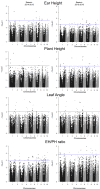Genome-wide haplotype-based association analysis of key traits of plant lodging and architecture of maize identifies major determinants for leaf angle: hapLA4
- PMID: 30840677
- PMCID: PMC6402688
- DOI: 10.1371/journal.pone.0212925
Genome-wide haplotype-based association analysis of key traits of plant lodging and architecture of maize identifies major determinants for leaf angle: hapLA4
Abstract
Traits related to plant lodging and architecture are important determinants of plant productivity in intensive maize cultivation systems. Motivated by the identification of genomic associations with the leaf angle, plant height (PH), ear height (EH) and the EH/PH ratio, we characterized approximately 7,800 haplotypes from a set of high-quality single nucleotide polymorphisms (SNPs), in an association panel consisting of tropical maize inbred lines. The proportion of the phenotypic variations explained by the individual SNPs varied between 7%, for the SNP S1_285330124 (located on chromosome 9 and associated with the EH/PH ratio), and 22%, for the SNP S1_317085830 (located on chromosome 6 and associated with the leaf angle). A total of 40 haplotype blocks were significantly associated with the traits of interest, explaining up to 29% of the phenotypic variation for the leaf angle, corresponding to the haplotype hapLA4.04, which was stable over two growing seasons. Overall, the associations for PH, EH and the EH/PH ratio were environment-specific, which was confirmed by performing a model comparison analysis using the information criteria of Akaike and Schwarz. In addition, five stable haplotypes (83%) and 15 SNPs (75%) were identified for the leaf angle. Finally, approximately 62% of the associated haplotypes (25/40) did not contain SNPs detected in the association study using individual SNP markers. This result confirms the advantage of haplotype-based genome-wide association studies for examining genomic regions that control the determining traits for architecture and lodging in maize plants.
Conflict of interest statement
The authors have declared that no competing interests exist.
Figures




References
-
- De la Barrera E, Martínez RO. Socio-ecological considerations on the persistence of Mexican heirloom maize. Maydica. 2018; 61(4): 10.
-
- Yang X, Gao S, Xu S, Zhang Z, Prasanna BM, Li L, et al. Characterization of a global germplasm collection and its potential utilization for analysis of complex quantitative traits in maize. Mol. Breeding. 2011; 28(4): 511–526.
-
- Băşa AG, Ion V, Dumbravă M, Temocico G, Epure LI, Ştefan D. Grain yield and yield components at maize under different preceding crops and nitrogen fertilization conditions. Agric. Agric. Sci. Proc. 2016; 10: 104–111.
-
- Fischer RA, Edmeades GO. Breeding and cereal yield progress. Crop Sci. 2010; 50: S–85.
Publication types
MeSH terms
LinkOut - more resources
Full Text Sources

